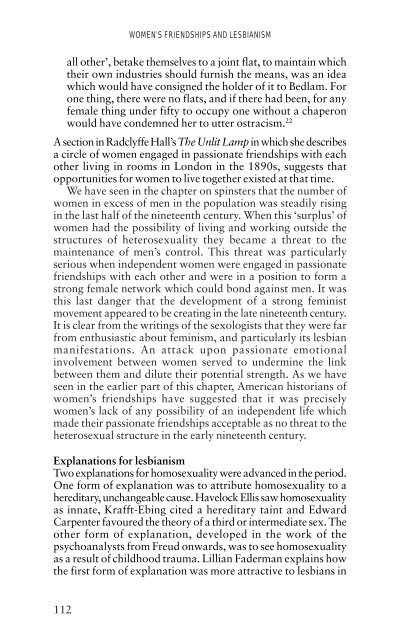The Spinster and Her Enemies - Feminish
The Spinster and Her Enemies - Feminish
The Spinster and Her Enemies - Feminish
Create successful ePaper yourself
Turn your PDF publications into a flip-book with our unique Google optimized e-Paper software.
WOMEN’S FRIENDSHIPS AND LESBIANISM<br />
all other’, betake themselves to a joint flat, to maintain which<br />
their own industries should furnish the means, was an idea<br />
which would have consigned the holder of it to Bedlam. For<br />
one thing, there were no flats, <strong>and</strong> if there had been, for any<br />
female thing under fifty to occupy one without a chaperon<br />
would have condemned her to utter ostracism. 22<br />
A section in Radclyffe Hall’s <strong>The</strong> Unlit Lamp in which she describes<br />
a circle of women engaged in passionate friendships with each<br />
other living in rooms in London in the 1890s, suggests that<br />
opportunities for women to live together existed at that time.<br />
We have seen in the chapter on spinsters that the number of<br />
women in excess of men in the population was steadily rising<br />
in the last half of the nineteenth century. When this ‘surplus’ of<br />
women had the possibility of living <strong>and</strong> working outside the<br />
structures of heterosexuality they became a threat to the<br />
maintenance of men’s control. This threat was particularly<br />
serious when independent women were engaged in passionate<br />
friendships with each other <strong>and</strong> were in a position to form a<br />
strong female network which could bond against men. It was<br />
this last danger that the development of a strong feminist<br />
movement appeared to be creating in the late nineteenth century.<br />
It is clear from the writings of the sexologists that they were far<br />
from enthusiastic about feminism, <strong>and</strong> particularly its lesbian<br />
manifestations. An attack upon passionate emotional<br />
involvement between women served to undermine the link<br />
between them <strong>and</strong> dilute their potential strength. As we have<br />
seen in the earlier part of this chapter, American historians of<br />
women’s friendships have suggested that it was precisely<br />
women’s lack of any possibility of an independent life which<br />
made their passionate friendships acceptable as no threat to the<br />
heterosexual structure in the early nineteenth century.<br />
Explanations for lesbianism<br />
Two explanations for homosexuality were advanced in the period.<br />
One form of explanation was to attribute homosexuality to a<br />
hereditary, unchangeable cause. Havelock Ellis saw homosexuality<br />
as innate, Krafft-Ebing cited a hereditary taint <strong>and</strong> Edward<br />
Carpenter favoured the theory of a third or intermediate sex. <strong>The</strong><br />
other form of explanation, developed in the work of the<br />
psychoanalysts from Freud onwards, was to see homosexuality<br />
as a result of childhood trauma. Lillian Faderman explains how<br />
the first form of explanation was more attractive to lesbians in<br />
112

















